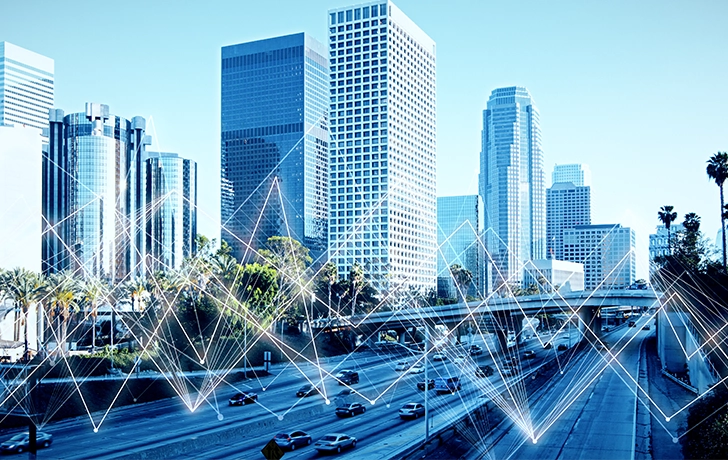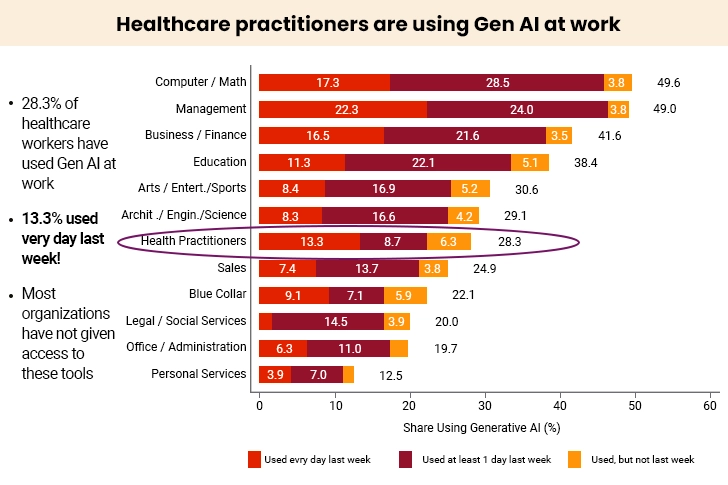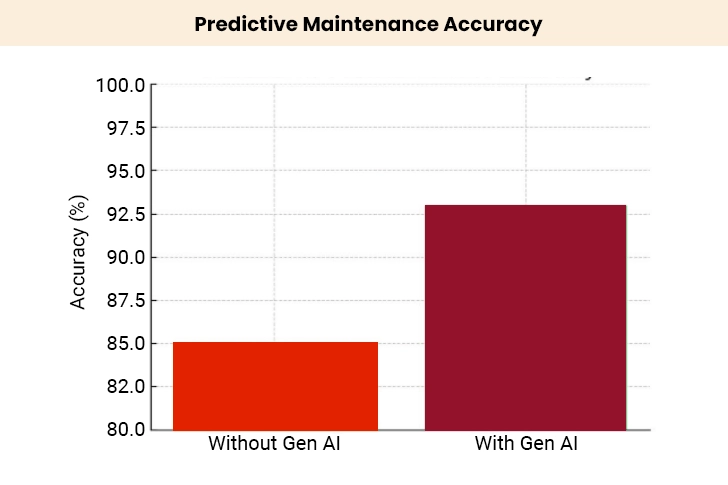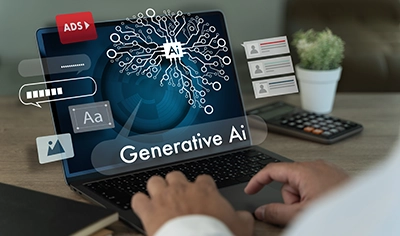AI has ushered in a new wave of transformative capabilities that are reshaping organizational strategies, fundamentally transforming the way businesses conceptualize, execute, and adapt their strategic imperatives. At the heart of this revolution lies Generative AI, a catalyst propelling businesses into uncharted territories of innovation, productivity, and efficiency by automating manual, time-intensive, and rule-based tasks that were previously done by humans. Besides propelling organizations beyond the realms of convention, this disruptive force compels businesses to reevaluate traditional notions of work dynamics, problem-solving, and creativity processes.
Built on top of foundation models, Generative AI can produce original content such as imagery, audio, video, computer code, text, simulations, synthetic data, and 3D renderings in response to text prompts. In other words, this disruptive technology can be used to generate various types of creative content based on the large volumes of unstructured or unlabeled data it is trained on. The interesting thing about this emerging technology is that it has something to offer for everyone, whether it’s a marketer aiming to captivate the audience, a financial analyst navigating complex markets, a healthcare professional seeking more accurate diagnoses, or an educator striving for personalized learning experiences. In a nutshell, Generative AI comes with an innate potential to revolutionize businesses across industries.
Table of Contents
What Are the Top Use Cases for Generative AI?
- Healthcare – Revolutionizing Diagnostics, Treatment, and Research
- Retail – Improving the Overall Customer Experience
- Insurance – Efficient Claims Processing
- Manufacturing – Revolutionizing Production Lines
- Marketing – Transforming the Way Companies Market Products
- Supply Chain and Logistics – Transforming Product Movement
- Customer Service – Solving Customer Problems Faster
What Are the Top Use Cases for Generative AI?
Generative AI has moved beyond experiments to practical uses. Given below are the real-life applications that reveal how this technology helps people complete tasks faster, generate new ideas, and find better solutions to common challenges.
1. Healthcare – Revolutionizing Diagnostics, Treatment, and Research
Generative Artificial Intelligence in healthcare has emerged as a game-changer since it offers innovative solutions that augment research, diagnostics, and treatment of longstanding health issues. This subset of AI has the ability to create new, realistic data or content based on information or patterns learned from existing datasets. Furthermore, this technology holds immense potential for transforming drug discovery, treatment planning, and personalized healthcare solutions.
Generative AI Use Cases in Healthcare
- a) Medical Imaging: Generative Artificial Intelligence is making strong strides in medical imaging by generating high-quality, synthetic images for X-rays, CT scans, and MRIs. This is beneficial in training ML models for tasks like organ segmentation, tumor detection, etc.
- b) Drug Discovery: The drug discovery process is not only time-intensive but also expensive. Generative AI helps in drug discovery by generating molecular structures for new drugs. It can also analyze existing chemical and biological data and propose novel molecules with therapeutic potential. This accelerates drug discovery timelines and reduces costs.
- c) Virtual Health Assistants: Intelligent chatbots and virtual health assistants powered by Generative Artificial Intelligence leverage NLP capabilities to understand and respond to patients’ inquiries, schedule appointments, provide medication reminders, and offer health-related information. By simulating human-like conversation, these intelligent assistants not only enhance patient engagement but also contribute to easy accessibility to healthcare resources, resulting in improved healthcare outcomes.
“Generative AI is revolutionizing drug discovery by simulating molecular structures at unprecedented speed.”
– Daphne Koller, Founder & CEO, insitro.
Navigating the Generative AI Landscape for Business Transformation
2. Retail – Improving the Overall Customer Experience
Generative Artificial Intelligence is making substantial inroads into the retail sector, offering a plethora of innovative solutions that not only revolutionize various aspects of the industry but also enhance the overall customer experience. Listed below are some popular use cases of this transformative technology in the retail sector.
Generative AI Use Cases in Retail
- a) Visual Merchandising: Generative Artificial Intelligence can be used to produce visually appealing and realistic product images that attract customers and increase conversions. It can generate high-quality, synthetic product images, combining features from different backgrounds, lighting conditions, and angles without the need for extensive photoshoots, which in turn contributes to an enhanced user experience. These synthetic images not only offer a cost-effective alternative but also allow retailers to respond promptly to changing trends.
- b) Dynamic Pricing: Generative AI can process real-time data on customer behavior, competitor pricing, market conditions, and other relevant factors to dynamically adjust product prices. This adaptive pricing model not only maximizes profitability but also ensures responsiveness to changing market dynamics.
- c) Personalized Marketing: Generative Artificial Intelligence can analyze a large volume of datasets comprising purchase history, customer behavior, and preferences to create highly targeted and personalized marketing content, including targeted email campaigns, product recommendations, and personalized advertisements. In other words, this technology allows retailers to deliver content that resonates on a personal level, resulting in enhanced customer engagement.
3. Insurance – Efficient Claims Processing
Generative Artificial Intelligence is reshaping the insurance industry by introducing innovative solutions that streamline operations, automate claims processing workflow, enhance risk assessment, and elevate customer engagement. Below is a detailed exploration of how this emerging technology is bringing about a paradigm shift in the insurance industry.
Use Cases of Generative AI in Insurance
- a) Fraud Detection and Prevention: Generative Artificial Intelligence plays a critical role in mitigating fraudulent activities within the insurance sector. By leveraging data analytics and advanced machine learning algorithms, Generative AI can analyze large datasets that include customer behaviors, historical claims, and external risk factors to identify patterns indicative of potential fraudulent activities. This disruptive technology continuously learns from historical data to detect anomalies and irregularities such as inconsistent information, unusual claim patterns, or suspicious activities.
- b) Automated Claims Processing: Generative Artificial Intelligence automates the entire claims workflow by extracting and analyzing relevant information from various documents, including forms, images, and textual data. By leveraging advanced Machine Learning algorithms, Generative AI can extract pertinent details, assess claim validity, and expedite the decision-making process. This not only streamlines the claims settlement process but also reduces the likelihood of human errors.
- c) Operational Efficiency and Cost Reduction: Generative Artificial Intelligence leverages Machine Learning algorithms and data analytics capabilities to optimize various insurance processes, including risk assessment, claim processing, and underwriting. This technology empowers insurers to streamline workflows, allocate resources more strategically, and focus on value-added services, which in turn leads to enhanced operational efficiencies and cost reductions.
Learn More About the Impact of Generative AI in Insurance
4. Manufacturing – Revolutionizing Production Lines
Manufacturing companies are using smart Gen AI programs to make their work better and faster. These programs can think and learn like humans, but much faster. They help factories make better products, fix machines before they break, check quality, and manage supplies. This technology is changing how things are made and helping companies save money while making customers happier.
Use Cases of Gen AI in Manufacturing
- a) Product Design Optimization: Gen AI helps companies create better product designs by analyzing lots of information about what customers want and how products should work. Gen AI programs can suggest new shapes, materials, and features that make products robust, reasonable, and useful. They can also test thousands of different design ideas quickly without actually making the products first. This helps companies make things that people really want to buy.
- b) Predictive Maintenance: Gen AI programs can monitor machines in factories and inform workers when something might break before it actually happens. They look at sounds, temperatures, and other signs that show when a machine is getting tired or worn out. This helps companies fix problems early instead of waiting for machines to stop working completely. Workers can also plan repairs during quiet times, so production does not stop suddenly.
- c) Quality Control: Gen AI helps factories check if products are made correctly by looking at them carefully and quickly. These smart programs can spot tiny problems that human eyes might miss and can check thousands of products in minutes. They compare each product to perfect examples and immediately inform workers if something is wrong. This means fewer bad products reach customers and companies can fix problems right away.
5. Marketing – Transforming the Way Companies Market Products
Marketing businesses have started using generative artificial intelligence to connect with customers in better ways. This technology helps them create interesting content, understand what different customers want, manage their social media accounts, and test which ideas work best. Companies are finding that Gen AI makes their marketing more effective and helps them sell more products to happy customers.
Use Cases of Generative AI in Marketing
- a) Content Creation: Creating fresh content for websites, ads, and social media takes a lot of time and effort. Gen AI helps marketers write blog posts, product descriptions, and advertising messages much faster than before. This technology can create different versions of the same message to appeal to various groups of people. Marketers can now focus on bigger ideas while AI handles the writing tasks that used to take hours every day.
- b) Audience Segmentation and Personalization: Every customer is different and wants different things from brands. Gen AI helps companies figure out what each customer likes by looking at their shopping habits and interests. This information helps companies send the right messages to the right people at the right time. Customers get offers and content that actually resonates with them, which makes them more likely to buy something and stay loyal to the brand.
- c) Social Media Management: Managing social media accounts across different platforms can be overwhelming for businesses. Gen AI helps companies schedule posts, respond to customer comments, and keep track of what people are saying about their brand. It can also suggest the best times to post and what type of content will get the most attention. This helps businesses stay active on social media without spending all day managing their accounts. d) A/B Testing: Companies often want to know which version of an ad or website works better with customers. Gen AI makes testing different versions much easier and faster than doing it manually. It can run multiple tests at the same time and quickly tell businesses which approach gets better results. This helps companies make smart decisions about their marketing based on real data instead of just guessing what might work.
6. Supply Chain and Logistics – Transforming Product Movement
Supply chain and logistics companies have begun using generative artificial intelligence to make their operations run more efficiently. This technology helps them predict what customers will need, plan better routes for deliveries, and manage their warehouse stock more effectively. Businesses are discovering that Gen AI reduces costs and helps them deliver products faster while keeping customers satisfied with reliable service.
Generative AI Use Cases in Supply Chain and Logistics
- a) Demand Forecasting: Knowing how much of each product customers will want in the future is one of the biggest challenges for any business. Gen AI helps companies look at past sales data, seasonal patterns, and current market trends to predict future demand more accurately. It considers many different factors that affect buying behavior and gives businesses a clearer picture of what to expect. This helps companies produce the right number of products without running out or having too much leftover stock.
- b) Supply Chain Planning: Planning how products move from factories to customers involves many complicated decisions about routes, timing, and resources. Gen AI helps companies figure out the best ways to organize their supply chains by analyzing traffic patterns, weather conditions, and delivery costs. It can quickly adjust plans when unexpected problems happen, like road closures or supplier delays. This helps businesses keep their promises to customers even when things don’t go as originally planned.
- c) Inventory Optimization: Keeping the right number of products in warehouses is a delicate balance that affects both costs and customer satisfaction. Gen AI helps companies decide exactly how much inventory to keep on hand by studying sales patterns and delivery times. This technology considers factors like storage costs, product shelf life, and seasonal demand changes to make smart recommendations. This prevents businesses from wasting money on storing too much while ensuring they never run out of popular items that customers want.
7. Customer Service – Solving Customer Problems Faster
Customer service departments have started using generative artificial intelligence to help customers faster and more effectively. This technology allows companies to answer questions instantly, solve problems without making customers wait, and handle many requests at the same time. Businesses are finding that Gen AI improves customer satisfaction while reducing the workload on their support teams, making everyone happier with the service experience.
Use Cases of Generative AI in Customer Service
- a) Chatbots and Virtual Assistants: Many companies now use Gen AI-powered chatbots to talk with customers who need help or have questions. These digital assistants can understand what customers are asking and provide helpful answers right away, even when human agents are busy or unavailable. This technology learns from previous conversations to give better responses over time. Customers get immediate help for common problems while human agents can focus on more complex issues that need personal attention.
- b) Workflow Automation: Customer service involves many repetitive tasks like sorting emails, updating customer records, and sending follow-up messages. Gen AI helps automate these routine activities, so human agents can spend more time actually helping customers with their problems. This technology can automatically route customer requests to the right department and even suggest solutions based on similar cases from the past. This makes the whole customer service process faster and more efficient for everyone involved.
Exploring Generative AI’s Impact on Transforming Customer Experience
Drive Business Impact with Damco’s Expertise
The transformative power of Generative AI is nothing short of revolutionary. As we navigate through the intricate landscapes of businesses across industries, it becomes evident that embracing this disruptive technology is a strategic imperative to drive innovation, efficiency, and productivity. If you are also planning to harness the power of this emerging technology, it’s wise to seek Generative AI consultation from a reliable partner.








